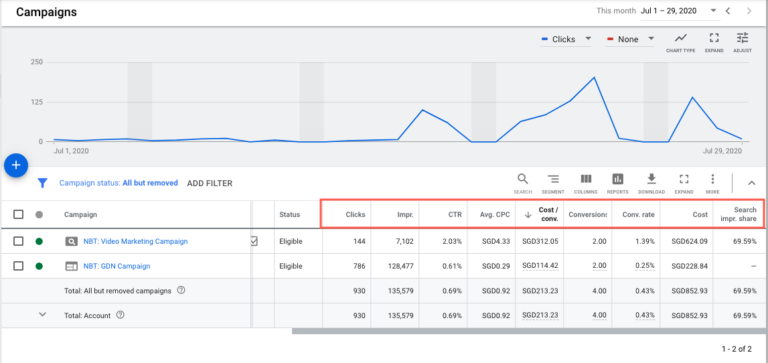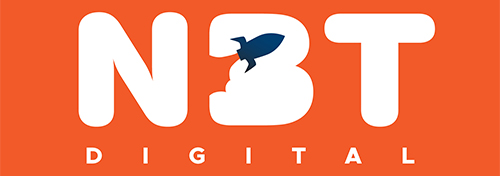
29 Jul Understand All These SEM Metrics Before You Start Investing In Digital Marketing
Gone are the days where companies can only invest in television or billboard advertising where these channels leave little trace as to how effective these type of advertising is and their direct return on investment.
The great thing about search engine marketing is that you can literally track everything.
If you are like many of the marketers out there, you would probably have many campaigns running concurrently, and guess what? The problem really starts if you can’t keep track of the thousands of keywords and ads that you are running. Today, we will show you the key metrics that one need to focus on when running a SEM search campaign.
If you main objective for your SEM campaign is to drive conversions, we strongly recommend you having these metrics in front of you:

Clicks
By definition, this metrics basically just means the total number of times that users have clicked on your ads.
Clicks should not be the main metrics to judge a campaign’s success.
You really want to be asking:
– How relevant was the search term?
– How engaged was this traffic?
– Did this user take action on your website?
Impressions
This is a metrics that is often confused with clicks. By definition, impressions is the total number of times your ad is shown on the search engine results page (SERP).
For example, if the same user searches for your service offering and sees your ad 10 times. This would garner 10 impressions regardless of the number of times the user clicks on your ad.
Click Through Rates
This brings us to the next point – click through rate (CTR). To under CTR, remember this simple formula:
CTR = (Total Clicks on Ad) / (Total Impressions) regardless if it is a new user or the same user searching.
Why is CTR important?
CTR reflects the effectiveness of your ads. Because, you cannot expect to turn a user into a customer right away just by a user looking at your ads. The key here is to entice users to click on your ad so that they can end up on your landing page where your landing page will be your online salesman, where its only job is to finally sell to the prospect.
If your ads do not have a high CTR, this means that users are either not interested in clicking on your ad or worst, they are clicking on your competitors’ ads instead and giving them the chance to sell their service offering to them.
The way to optimise your CTR, is to craft ads that speak to your target audience and stand out from the competition.
“The key here is to get them to click, not to sell”
Case Study: Lets just say I’m offering digital marketing services
If you knew about this principle, your ad text would look more like B than A:
A) Digital Marketing Services | 1-Stop Digital Marketing Company
A) Digital Marketing Services | Free Consultation
A) Digital Marketing Services | 40% Off Corporate Rates
B) Digital Marketing | What 90% Of Agencies Are Not Telling You
B) Digital Marketing | Guide On How You Can X3 Your Leads In 2 Week
How you craft your ad texts definitely depends on several factors, but essentially, you want to be able to have a healthy CTR to entice your users to end up your landing page so that you can leave it to your landing page to do the selling for you.
Average Cost Per Click
Avg CPC is the average amount that you are being charged for each click.
One of the ways to calculate on a campaign level is = taking your total cost / total number of clicks.
– If you are being charged for $0.40 for one of your keyword and
– you are being charged for $0.60 for another keyword,
Your avg CPC is $0.50 ($1 / 2 = $0.50)
Avg CPC in this day and age really depends on your selected bidding strategy, and it really depends on your competition; on how competitive your keyword is and how aggressive is your competition bidding for the exact same keyword.
Conversion & Cost per conversion
Conversion refers to the time when a visitor in your website completes a desired action and goal.
Common conversion actions include: submit enquiry form, email signups, call a number, whatsapp the company, etc.
Cost per conversion = number of conversion / number of clicks
If out of 10 clicks, you get 1 conversion, this means that your conversion rate is = 10%.
Conversion rate largely depends on 2 factors:
– Your keywords targeted (are they relevant and attracting the right target audience)
– Your landing page experience (are you appealing to your target audience and getting them to take action easily)
Impression share
Impressions share is the percentage of impressions that your ads receive compared to the total number of impressions that your ads could get.
E.g. If a user searches for your targeted keyword 10 times, and your ad is shown 9 times. Your impression share = 90%
Having a higher impression share just means that in general, a user will most of the time see your ads whenever they search for your targeted keywords.
Quality Score
Quality score will affect two things:
– The frequency of your ads being shown (higher quality score = likelihood of higher frequency)
– Average CPC (higher quality score = lower averge CPC)
Quality score is Google’s rating of the relevancy of your keywords, ads and user experience on your website.
The aim here is to always get a higher quality score (the maximum is 10/10).
A higher quality score will result in higher ad rankings and frequency, and lower cost per click.
Now that you have understood the key metrics in the search realm, you can now proceed to interpret the results and craft out actions steps to optimise on your campaign further:
- If CTR is low > adjust your ad texts
- If your cost per lead is high > look into which ad groups and keywords are bringing up the campaign’s CPL > move on to the search terms and check if the search terms are highly relevant with high buying intend
- If conversion rate is low > look into your targeted keywords and look into your landing page
- Avg CPC has increased > look into which ad groups and keywords are bringing up the campaign’s avg CPC > ask if they are relevant and contributing to conversions
After which, you want to move on to these questions:
1. Am I targeting high intend keywords / am I attracting the right traffic to my landing page?
2. Are my ad texts enticing my target audience to click on my ads?
3. Is my landing page optimised for conversions?
4. Am I garnering sales and getting a healthy return in my investment (ROI)?
Your paid campaign will provide you much valuable information and it is really the advertiser’s job to turn those data and information into actionable steps and strategies to achieve marketing goals.

